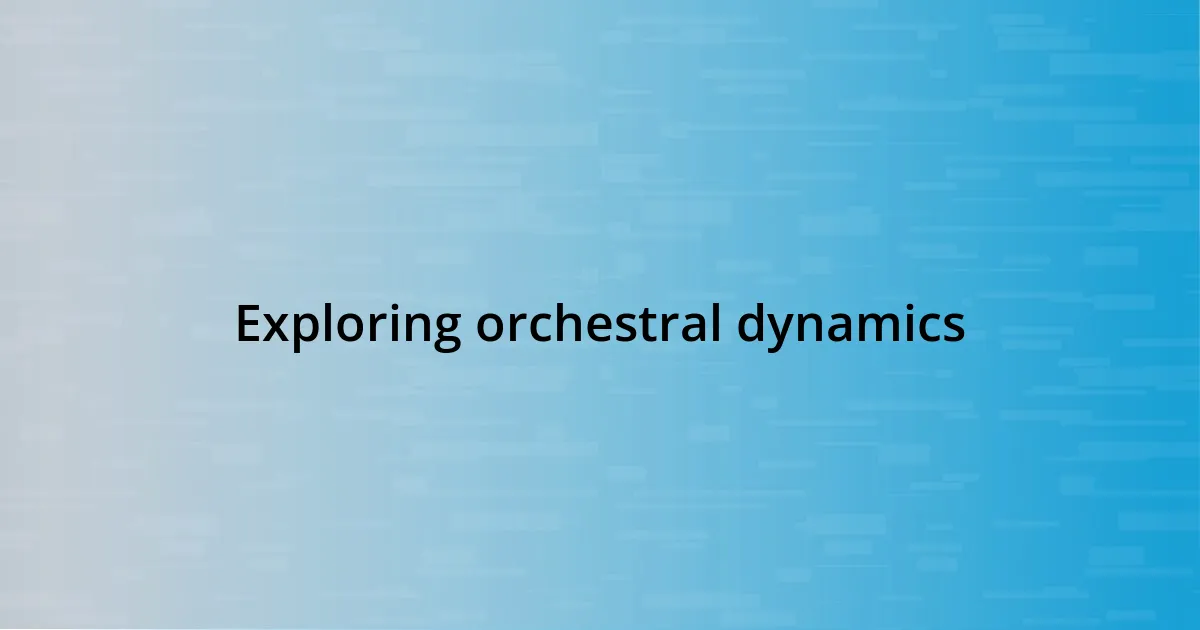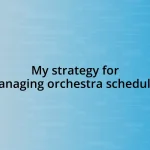Key takeaways:
- Orchestral arrangements involve complex interactions between instruments, creating emotional depth and storytelling through music.
- Harmonic layering adds richness and texture, enhancing the overall listening experience while evoking various emotions.
- Techniques such as dissonance, dynamic contrast, and rhythmic displacement play crucial roles in creating tension and engaging the audience.
- Aspiring arrangers should explore diverse musical styles, analyze classic scores, and embrace experimentation to enhance their creativity.

Understanding orchestral arrangements
When I first encountered orchestral arrangements, I was captivated by the sheer complexity behind them. Each instrument not only contributes its unique voice but also harmonizes with others, creating an intricate tapestry of sound. Have you ever listened closely to how the violins respond to the brass? It’s like a musical conversation, each part carefully woven together to enhance the overall emotional impact.
Understanding orchestration is crucial for appreciating how diverse instruments interact within a piece. I remember the thrill of attending a live orchestra performance, where the moment the conductor raised their baton, the air was charged with anticipation. You could almost feel the way the musicians align their energies to illustrate the composer’s vision—each note a deliberate choice.
Moreover, orchestral arrangements often reflect the cultural and emotional context of their time. Think about how powerful it is to hear a symphony that conveys the struggles and triumphs of its era. When I listen to those grand crescendos, it stirs a sense of connection not just to the music itself but to the history it represents. Isn’t it fascinating how sound can encapsulate stories across generations?

The role of instruments
The variety of instruments in an orchestra plays a vital role in shaping the overall sound. Each instrument has its own timbre, or tonal quality, which contributes distinct colors to the musical palette. I remember sitting in a concert hall, completely engrossed as the cellos dipped into their rich, warm tones while the flutes danced above, creating a delightful contrast. This interplay fascinates me; it paints a sonic picture where every instrument is essential, none overshadowing the other.
Instruments are not just tools; they embody emotional capacities that resonate with observers. For instance, the power of the percussion section often brings an intense energy, almost like a heartbeat driving the music forward. I once felt invigorated while listening to a thunderous drum solo amidst a quiet orchestra, almost as if the drums spoke a language of their own. This dynamic can shift the mood from serene to exhilarating, offering a physical response to sound—who hasn’t felt their heart race during a climactic moment in a symphony?
Finally, the role of instruments extends to storytelling within the music. When different sections take turns leading, it gives a sense of dialogue. I experienced this firsthand during a performance where the clarinet called out to the oboe, and the exchange told a story of longing and resolution. This narrative quality turns orchestral arrangements into emotional journeys, allowing listeners to connect deeply through shared experiences.
| Instrument | Role in Arrangement |
|---|---|
| Violin | Melody and Harmony |
| Cello | Rich Bass Lines |
| Flute | Light, Airy Melodies |
| Trumpet | Bright, Bold Statements |
| Percussion | Rhythm and Energy |

Importance of harmonic layering
The importance of harmonic layering in orchestral arrangements can’t be overstated. It’s like adding depth to a painting; each layer brings out a shade of emotion that can resonate with the listener. For me, there’s something almost magical about how those layers weave together. I remember a performance where the lush strings harmonized with the delicate woodwinds, creating a vibrant soundscape that felt alive. It truly struck me how each layer supports the other, enhancing the richness of the music.
When I listen to a piece with well-crafted harmonic layering, I often find myself lost in its ebb and flow. The interplay of voices creates a sonic tapestry that feels immersive. Here are some key aspects of harmonic layering:
- Emotional Depth: Layers of harmony evoke a range of emotions, allowing the audience to feel the nuances of the music.
- Tension and Resolution: The careful build-up and release through harmonic layers can create a compelling narrative, keeping the listener engaged.
- Textural Complexity: Multiple layers allow for intricate textures, preventing the music from feeling flat or monotonous.
- Cohesion: Harmonically layered arrangements create a sense of unity within the orchestra, as parts blend together to form a cohesive whole.
- Dynamic Range: Layering enables the music to swell and recede, adding excitement or serenity as necessary.
In my experience, these elements combine to create unforgettable musical moments. Each time the harmony unfolds, it’s like peeling back the layers of an intricate story, inviting you to discover more with each listen.

Techniques for creating tension
Creating tension in orchestral arrangements is an art form that involves various techniques. One of my favorite methods is the use of dissonance. I recall attending a symphony where the strings played in sharp, jarring intervals, creating an uncomfortable feeling that heightened the audience’s anticipation. It sparked a sense of unease, reminding me how music can evoke powerful emotions without a single word. Isn’t it intriguing how something as simple as note choice can shift the atmosphere in an instant?
Another effective technique I’ve encountered is dynamic contrast. In one memorable concert, the orchestra built to a thunderous crescendo only to drop to a whisper. The sudden silence that followed was palpable, wrapping the audience in suspense. I found myself holding my breath, anxiously waiting for the next sound. Moments like these highlight how fluctuations in volume can not only create tension but also create a powerful emotional response. Have you ever experienced a moment in music that made you feel completely vulnerable?
Finally, rhythmic displacement is a captivating tool in constructing tension. I remember being swept away by a particularly intense piece where the beats seemed to lag and then rush unexpectedly. It felt like a thrilling chase, pulling me deeper into the experience. Such rhythmic shifts keep listeners on their toes, never quite knowing what to expect next. It’s a reminder of how rhythm can manipulate time and perception, adding layers of intrigue to the musical narrative. Isn’t it fascinating how the manipulation of rhythm can transform our listening experience?

Exploring orchestral dynamics
Exploring orchestral dynamics reveals a world of emotional and auditory contrasts. The interplay between soft and loud passages can create a sense of ebbs and flows that captivate me. I recall an evening at the concert hall when the conductor effortlessly guided the orchestra from a delicate whisper to a resounding, powerful forte. That shift felt like a wave crashing against the shore, immersing me in an emotional tide that was simply exhilarating. Have you ever sensed the music swell and suddenly envelop you?
One aspect of dynamics I find particularly striking is the role of individual instruments in shaping the overall sound. For instance, woodwinds often venture into softer, more intimate ranges, while brass sections provide bold, dramatic statements. I once experienced an exhilarating moment when the clarinet’s gentle melody danced gracefully above the thunderous brass section, contrasting yet complementing the grandeur of the orchestra. It was in that moment I truly felt the power of dynamics—how the blending of soft and loud moments can tell a story just as compelling as any narrative.
Additionally, I’m fascinated by how dynamic range contributes to the orchestra’s emotional impact. The gradual crescendo can instill a sense of anticipation, like a deep breath before diving into an unknown. I distinctly remember a piece where the strings began tenderly, slowly building up to an explosive finale. That transition not only heightened my emotional investment but also connected me to the performers. Have you ever been transported by a dynamic shift so powerful that you found yourself on the edge of your seat? It’s those moments of contrast that define our orchestral experiences and resonate with us long after the last note has faded.

Analyzing famous orchestral works
Analyzing famous orchestral works reveals layers of complexity and emotion that often go unnoticed. Take Tchaikovsky’s “1812 Overture,” for example. The iconic cannon fire integrated into the orchestral fabric creates a visceral response that I felt in my chest the first time I heard it live. It’s astounding how such a bold element transforms the entire atmosphere, evoking both excitement and somber reflection. Have you ever experienced a musical moment that left you breathless?
Moving into the world of Mahler, his Symphony No. 2, known as the “Resurrection Symphony,” exemplifies the juxtaposition of life and death. I’ll never forget the feeling of eerie stillness before the powerful choral finale erupted into a celebration of life. Every time I listen, I find myself drawn into the emotional depth of the piece. It’s remarkable how orchestral arrangements like this can evoke such profound personal reflections. Isn’t it fascinating how a symphony can mirror our own struggles and triumphs?
Another piece that often captivates me is Stravinsky’s “The Rite of Spring.” The primal energy pulsating throughout the score illustrates how rhythm plays a critical role in storytelling. I vividly recall attending a performance where the audience’s collective tension grew, culminating in a euphoric, chaotic outburst by the orchestra. That raw intensity was electrifying, reflecting our own human experiences of conflict and resolution. Have you ever felt swept away by the sheer power of orchestral rhythm? It’s just one example of how orchestral music can encapsulate a wide range of emotions in a way that resonates deeply with listeners.

Tips for aspiring arrangers
To truly thrive as an arranger, I suggest immersing yourself in a variety of musical styles. This means listening to not just orchestral music but also jazz, pop, and even traditional folk music. I remember rediscovering jazz arrangements one afternoon and feeling inspired by how freely the horns would interact with each other. Have you ever stumbled upon a genre that unexpectedly sparked your creativity? It’s incredible how diverse influences can breathe new life into your own arrangements.
Another tip I find invaluable is to analyze scores of your favorite pieces. I often sit down with the sheet music of Beethoven or Debussy and trace how they constructed their works. It’s like having a conversation with the composers themselves. You’d be surprised to find patterns and techniques that resonate with you. Isn’t it enlightening to uncover the secrets behind what makes certain arrangements so compelling?
Finally, don’t shy away from experimenting. I clearly remember a time I took a beloved ballad and reimagined it as a lively swing piece. Initially, there was hesitation, but watching the musicians bring that reinterpretation to life was electrifying. Have you ventured to rewrite a piece in a different style? The thrill of seeing your ideas transform can fuel your passion for arranging even more. It’s about taking risks and enjoying the journey along the way.














